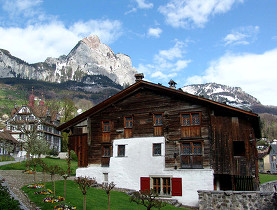Europe’s oldest wooden house still going strong

It is the summer of 1287 in Schwyz in central Switzerland, four years before activists in this region signed the Federal Charter, the country's founding document.
A well-to-do local family is in the middle of building a fine two-storey wooden house. They’ve already cut the timber from the local forest and they are helping the master carpenters assemble their dream home.
They are proud of their comfortable new dwelling with its modern blockhouse design and practical layout. The family, whose name we do not know, hope their house will last and be passed on to the next generation.
Amazingly the house still stands more than 700 years later, now a museum and the oldest surviving wooden house in Europe.
By some quirk of fate the House of Bethlehem survived the ravages of time, a fire which destroyed most of the village in the seventeenth century and the kind of wrangling that led to the even older Nideröst House (1176), just a stone’s throw away, being dismantled and put into storage in 2001.
Peace and prosperity
Schwyz is a rural community where peace and continuity have blossomed into prosperity over many centuries. Bethlehem is one of a group of 12 ancient wooden houses in Schwyz – which happen to be the oldest surviving in Europe. And most of them are still lived in.
“These may look like simple farmhouses from the outside but it was only the wealthy who could afford to build a structure as complicated and comfortable as this,” Markus Bamert, monument conservator for Schwyz, explained on a walkabout. The poor lived in much simpler shacks based on wooden posts that have long since disappeared.
The original occupants of Bethlehem may have been well off but they still had to work hard. They would have earned their living from farming, supplemented through military service and administrative roles in the town.
Despite the small dimensions of the rooms and the low ceilings, people still choose to live in these ancient houses today and therein lies the secret of their longevity.
Archaeologist Georges Descoeudres has studied the Schwyz group of houses closely. He worked on the exact dating of many of the buildings through dendrochronology, or tree ring dating.
“These houses have survived because they were always lived in and used in a good manner. The moment a house is no longer in use, it vanishes,” he explained.
New life
Bethlehem House was last occupied in the 1980s, divided into two apartments. As a museum it still gets the necessary upkeep and care.
In nearby Steinen work is underway on the restoration of a house one generation younger, from 1320.
Bamert oversees the building work, making sure all the specifications and materials are in line with preservation rules. He is glad that the old house will soon have a young family breathing new life into a design that was conceived centuries ago.
Houses as old as this inevitably have had bits added and replaced over the centuries as new generations did their best to improve on the original.
Interior walls are added or taken away, a new floor is created over the open kitchen space, a lean-to is upgraded to an extension. The windows are usually the first to be changed, although even an untrained eye can find the originals with a little tip on what to look for.
Despite these modifications, if the mainframe, walls and supporting beams remain, the house can be dated back to the age of these original materials.
While Bethlehem, as old as Notre Dame in Paris, holds the age record for a wooden dwelling, much of the old housing stock in eastern Europe has yet to be dated, which means there may be competition out there.
Moving house
Not only have the Schwyz houses been added to over the years, they may also have changed location more than once.
It was common practice in the Middle Ages and early modern times to dismantle houses and reassemble them on other sites, according to Descoeudres.
“There were even entrepreneurs in the sixteenth century who made houses in one site to be sold and moved on,” he said.
Moving an existing house was cheaper and less time-consuming than building a new one, and some families brought their houses with them when they moved to work in a new area. Likewise, if an old house burned down, the owners might purchase another one and transport it to the original site.
“We know this partly from written sources and partly from archaeological excavation,” Descoeudres explains. One study in canton Appenzell found that 20 per cent of the old wooden housing stock had been moved.
For now the House of Bethlehem is staying put, safely protected inside the walls of the Ital Reding estate, allowing visitors a moment of time travel to the distant past.
Wooden houses were more comfortable than stone in this temperate climate and in the Middle Ages, these are the kinds of dwellings most people lived in.
The build required the skills and labour of many. The wood was cut from nearby at the end of the winter and worked on while it was still fresh and supple. The fresher the wood, the easier it is to saw.
Bethlehem House, and the others of this vintage, was put together entirely with interlocking wooden beams. Wooden nails were used in the construction, metal was too expensive in those days.
The work had to be completed between spring and autumn, a great feat of teamwork and effort.
These homes were dark and smoky. The few windows were very small by today’s standards – only 40cm by 15cm – the ceilings low, 1.90m.
There was no chimney, the smoke from the central fire escaped through the windows and the shingles of the roof.
The smoke protected the wood as it aged, dying it black and making it as hard as rock. The houses were roofed with wooden shingles, held down with rocks.
There would have been 15 to 20 inhabitants in houses such as these, who would spend most of their time outdoors working (or in the kitchen), returning to the house to eat and sleep.
Switzerland owes its name and coat of arms to the town of Schwyz located between Lake Lucerne and the small Lake Lauerz.
In 1291 the cantons of Uri, Schwyz and Unterwalden entered into an alliance, and in 1315, by winning the Battle of Morgarten, they managed to drive out the Austrians.
The Museum of the Swiss Charters houses the most important documents of the early Swiss confederacy, including the confederation’s founding document.

In compliance with the JTI standards
More: SWI swissinfo.ch certified by the Journalism Trust Initiative












You can find an overview of ongoing debates with our journalists here . Please join us!
If you want to start a conversation about a topic raised in this article or want to report factual errors, email us at english@swissinfo.ch.